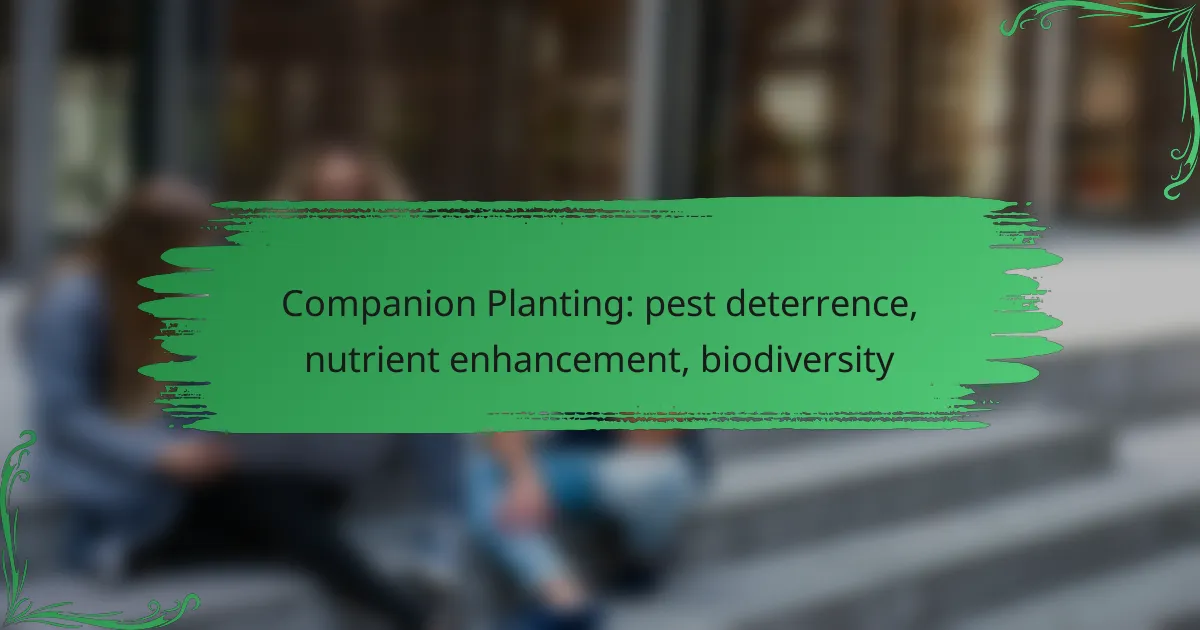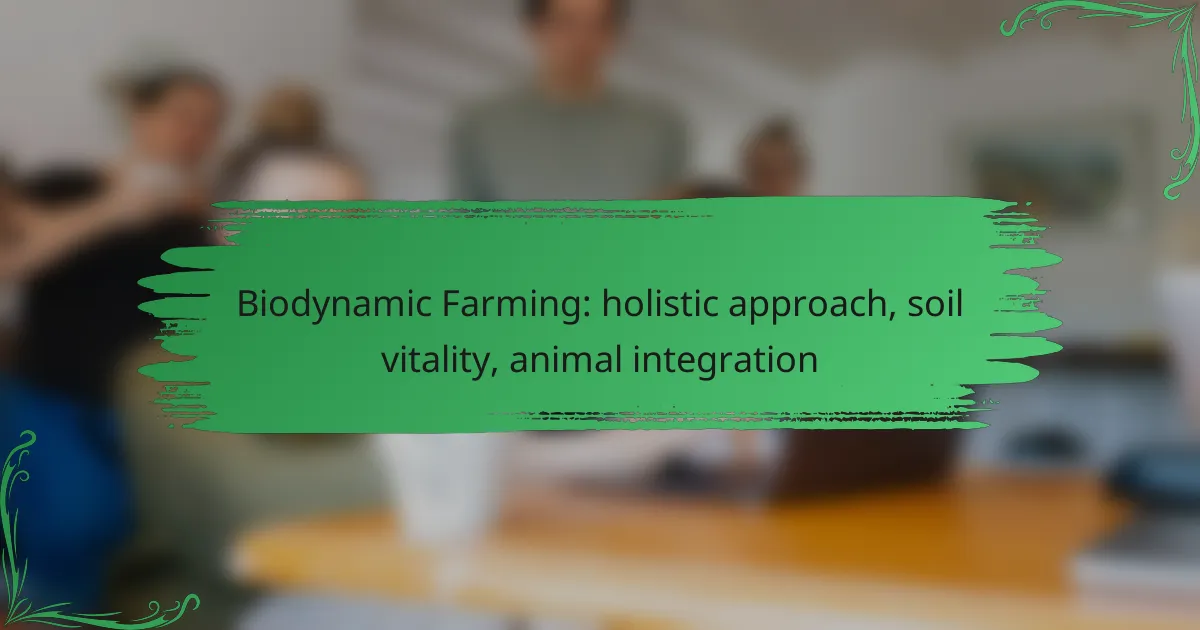No-till farming is an innovative agricultural practice that focuses on preserving soil health by minimizing disturbance. This method not only reduces erosion and enhances moisture retention but also significantly decreases labor requirements, making farming more efficient. By maintaining the natural structure and organic matter in the soil, no-till farming promotes a thriving ecosystem and supports sustainable crop production.

How does no-till farming preserve soil?
No-till farming preserves soil by minimizing disturbance, which helps maintain its structure and health. This method reduces erosion, enhances moisture retention, and promotes a thriving ecosystem within the soil.
Reduces soil erosion
No-till farming significantly reduces soil erosion by keeping the soil intact and covered with crop residue. This protective layer acts as a barrier against wind and water, preventing the loss of topsoil, which is crucial for nutrient retention.
Farmers can expect a decrease in erosion rates, often by 50% or more, compared to conventional tillage methods. This is particularly beneficial in regions prone to heavy rainfall or high winds.
Enhances soil structure
No-till practices enhance soil structure by allowing natural processes to occur without disruption. The soil remains compacted, which helps maintain its integrity and promotes better water infiltration.
Over time, this leads to improved aeration and root penetration, which are essential for healthy plant growth. Farmers may notice that their crops are more resilient to drought conditions due to this enhanced structure.
Increases organic matter
No-till farming increases organic matter in the soil by allowing crop residues to decompose naturally on the surface. This process enriches the soil with nutrients and improves its fertility.
As organic matter builds up, it enhances the soil’s ability to retain moisture, which is vital for crops, especially in drier climates. Farmers should aim for organic matter levels of at least 3-5% for optimal soil health.
Promotes beneficial microorganisms
No-till farming promotes beneficial microorganisms by creating a stable environment for them to thrive. The undisturbed soil supports diverse microbial communities that play a crucial role in nutrient cycling and soil health.
Healthy microbial populations can improve plant growth by enhancing nutrient availability and disease resistance. Farmers can encourage these microorganisms by minimizing chemical inputs and maintaining crop diversity in their rotations.

What are the labor benefits of no-till farming?
No-till farming significantly reduces labor requirements, making it an efficient agricultural practice. By minimizing soil disturbance, farmers can save time and effort while maintaining soil health and productivity.
Decreases labor hours
No-till farming can lead to a reduction in labor hours by eliminating the need for multiple passes over the field. Traditional tillage often requires several trips for plowing, harrowing, and planting, whereas no-till allows for direct planting into undisturbed soil. This can save farmers several hours per acre during the planting season.
For example, farmers may find that they can complete planting in a fraction of the time compared to conventional methods, allowing them to focus on other essential tasks or expand their operations.
Reduces machinery costs
By adopting no-till practices, farmers can lower their machinery costs significantly. Fewer trips across the field mean less wear and tear on equipment, which translates to lower maintenance and replacement expenses. Additionally, the need for specialized tillage equipment is minimized.
Farmers can often rely on a single planting machine instead of investing in multiple pieces of equipment, leading to substantial savings over time.
Minimizes tillage equipment needs
No-till farming reduces the necessity for various tillage implements, which can be costly to purchase and maintain. Instead of using plows and harrows, farmers can utilize no-till drills or planters designed for direct seeding. This shift not only saves money but also simplifies the farming operation.
As a result, farmers can allocate their resources more effectively, focusing on crop management and other critical aspects of their business rather than on maintaining a large fleet of tillage equipment.
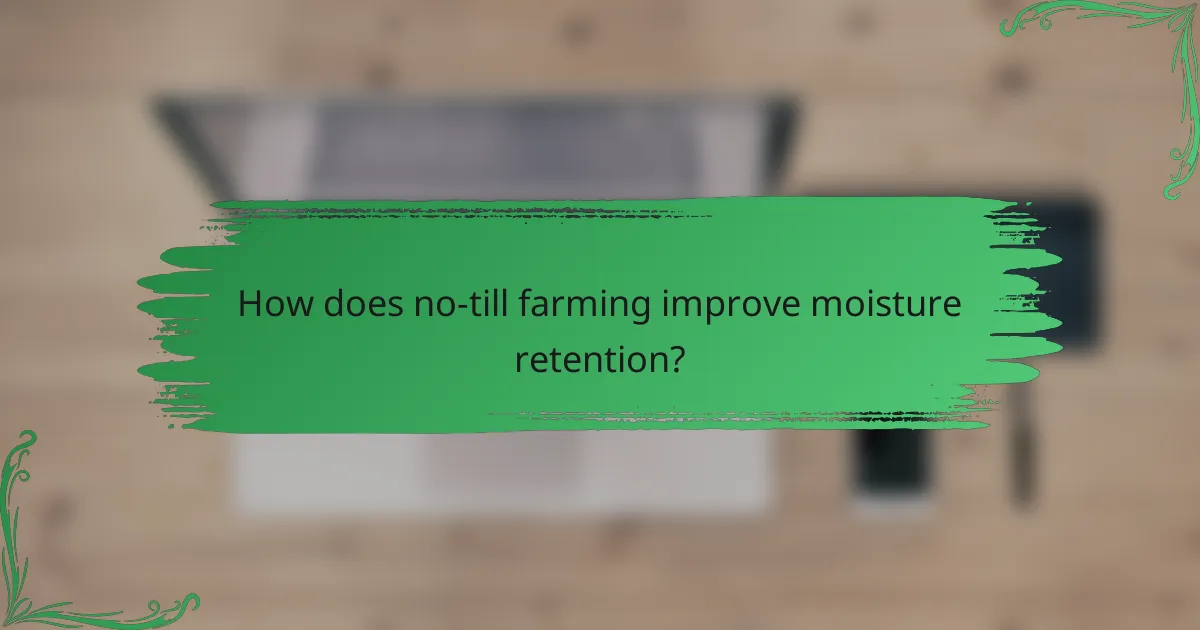
How does no-till farming improve moisture retention?
No-till farming enhances moisture retention by minimizing soil disturbance, which helps maintain the natural structure and organic matter in the soil. This practice leads to better water management, allowing crops to thrive even in drier conditions.
Increases water infiltration
No-till farming promotes increased water infiltration by preserving soil structure and reducing compaction. When soil is left undisturbed, the natural pores and channels remain intact, allowing water to penetrate more easily. This can lead to improved drainage and reduced runoff during heavy rainfall.
Farmers can enhance water infiltration by incorporating cover crops, which help create additional organic matter and root channels in the soil. This practice can significantly improve water absorption rates, especially in regions prone to heavy rains.
Reduces evaporation rates
No-till practices help reduce evaporation rates by maintaining a protective layer of residue on the soil surface. This layer acts as a barrier, shielding the soil from direct sunlight and wind, which are primary factors in moisture loss. By keeping the soil covered, farmers can retain more water for their crops.
Implementing no-till farming can be particularly beneficial in arid and semi-arid regions where water conservation is crucial. Farmers should consider timing their planting to coincide with seasonal rains to maximize moisture retention.
Enhances soil moisture levels
No-till farming enhances soil moisture levels by improving the soil’s ability to hold water. The organic matter preserved in no-till systems increases the soil’s water-holding capacity, allowing it to retain moisture for longer periods. This is especially important during dry spells when crops need consistent moisture.
To further enhance soil moisture, farmers can practice crop rotation and use cover crops, which contribute to soil health and moisture retention. Regular soil testing can help determine the best practices for maintaining optimal moisture levels in specific regions.
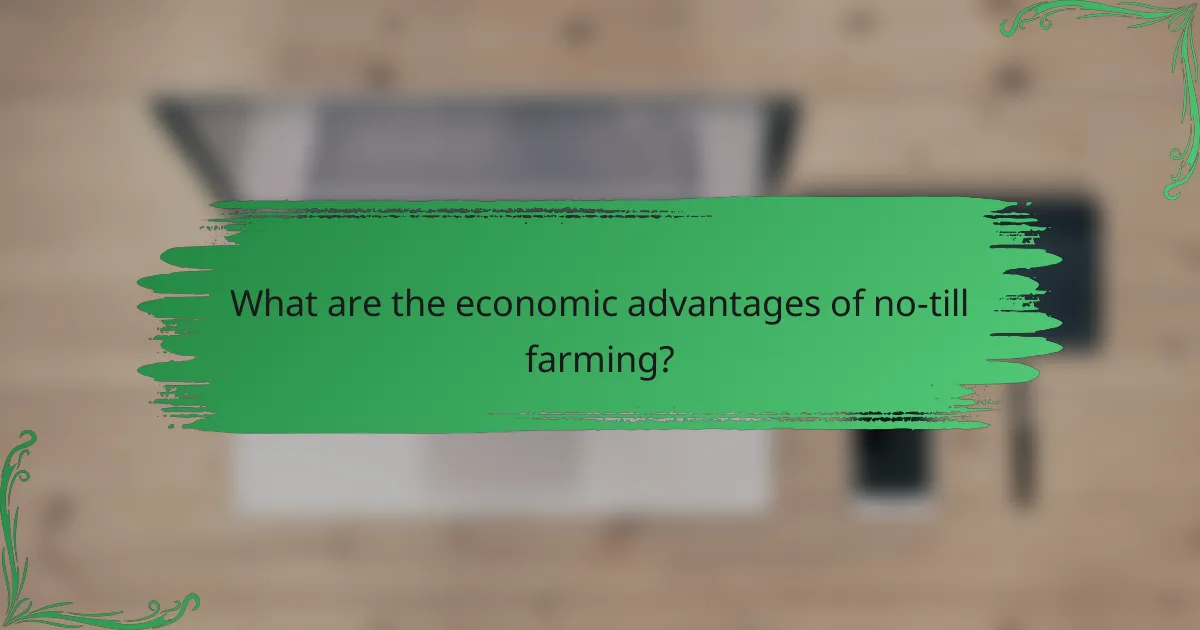
What are the economic advantages of no-till farming?
No-till farming offers several economic advantages, including lower input costs, higher crop yields, and increased profitability. By minimizing soil disturbance, farmers can reduce expenses related to labor, fertilizers, and water, while also enhancing their overall production efficiency.
Lower input costs
No-till farming significantly reduces input costs by minimizing the need for equipment and labor associated with traditional tillage methods. Farmers can save on fuel, maintenance, and labor expenses, as fewer passes over the field are required. Additionally, the preservation of soil structure can lead to lower fertilizer and pesticide usage, further cutting costs.
For instance, farmers practicing no-till may find that they can reduce their herbicide expenses by up to 30% due to improved weed management through cover crops and soil health. This can lead to substantial savings over time.
Higher crop yields
No-till farming can lead to higher crop yields due to improved soil health and moisture retention. The undisturbed soil structure allows for better water infiltration and root development, which can enhance plant growth. This method also promotes beneficial microbial activity, contributing to nutrient availability for crops.
Studies have shown that no-till systems can increase yields by 10-20% compared to conventional tillage, particularly in regions prone to drought. Farmers who adopt this practice often notice a more resilient crop performance under varying weather conditions.
Increased profitability
The combination of lower input costs and higher crop yields directly contributes to increased profitability for farmers using no-till practices. By reducing expenses and enhancing production, farmers can achieve better profit margins, making their operations more sustainable in the long run.
For example, a farmer who saves on labor and inputs while increasing yields may see a profit increase of 15-25% annually. This financial benefit can be crucial for farmers looking to invest in new technologies or expand their operations.
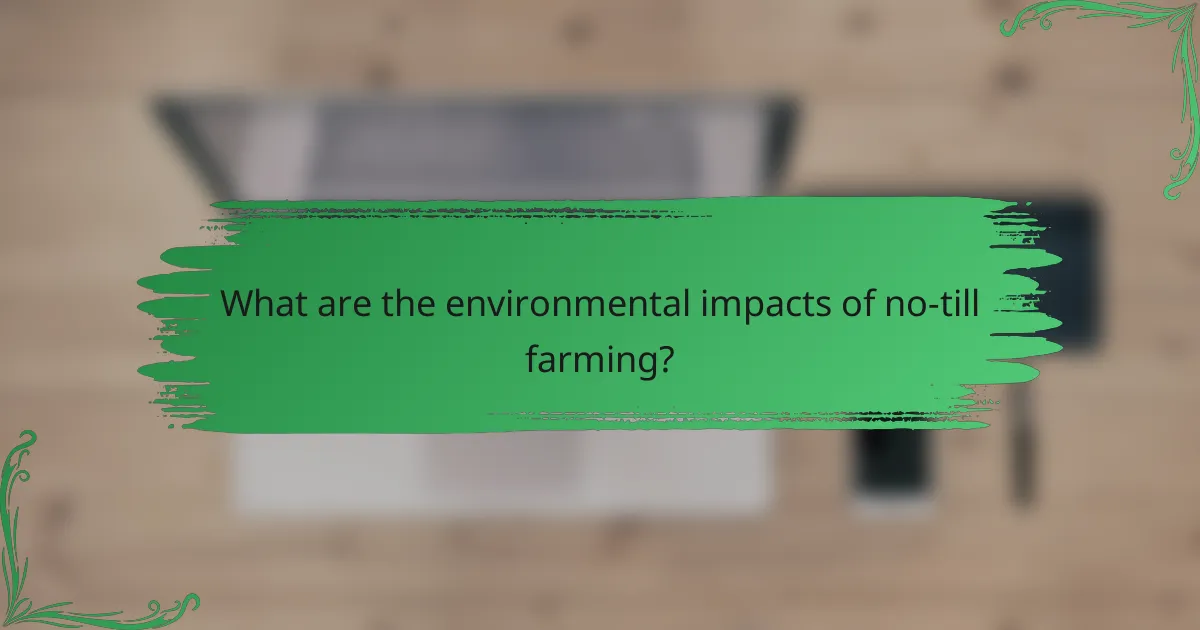
What are the environmental impacts of no-till farming?
No-till farming significantly benefits the environment by preserving soil health, reducing labor, and enhancing moisture retention. This method minimizes soil disturbance, which leads to improved carbon storage and biodiversity while promoting sustainable agricultural practices.
Reduces carbon footprint
No-till farming helps lower the carbon footprint by sequestering carbon in the soil. By avoiding soil disturbance, carbon remains trapped in the ground rather than being released into the atmosphere. This practice can reduce greenhouse gas emissions associated with traditional tillage methods.
Farmers adopting no-till techniques can see a decrease in fuel consumption, as less machinery is needed for soil preparation. This not only cuts costs but also contributes to lower overall emissions, making it a more sustainable option.
Improves biodiversity
No-till farming enhances biodiversity by creating a stable habitat for various organisms. The undisturbed soil supports beneficial microbes, earthworms, and other wildlife that contribute to a healthy ecosystem. This diversity can lead to improved soil structure and fertility.
Additionally, no-till practices encourage the growth of cover crops, which provide food and shelter for wildlife. These crops can also suppress weeds and pests, reducing the need for chemical interventions and promoting a more balanced agricultural environment.
Enhances ecosystem services
No-till farming enhances ecosystem services such as water retention and soil erosion prevention. The intact soil structure allows for better infiltration of rainwater, reducing runoff and improving moisture availability for crops. This is particularly beneficial in regions prone to drought.
Moreover, the practice helps prevent soil erosion by maintaining ground cover, which protects the soil from wind and water damage. Farmers can benefit from increased crop yields and reduced input costs, making no-till a practical choice for sustainable farming.


